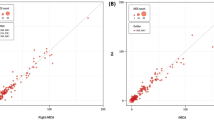Microembolic signals (MES), detectable by transcranial Doppler, are usually observed in patients with prosthetic valves. The clinical relevance of this finding is still unsettled. We evaluated the presence and number of MES and the degree of anticoagulation in 47 patients submitted to aortic or mitral valve replacement with mechanical prostheses at least 6 months before, with normal cardiac function and no other possible cardiac or carotid sources of cerebral embolism. Each patient was submitted to transcranial Doppler of both middle cerebral arteries for 45 minutes. Detection of MES was based on the double presence of the high intensity signal at two different depths with temporal delay, using a dedicated software with visual and acoustic confirmation. MES were observed in 18 patients (38.3%). Among them, 9 (19.1%) had 1–2 MES, and 9 (19.1%) had 3 or more MES. Twenty patients had an International Normalized Ratio (INR) ? 2.0, patients with the highest number of MES having the lowest INR (ANOVA: F = 4.21, p <0.01). No differences in MES number were observed between patients with either mitral or aortic valve replacement. The finding of a relationship between the number of MES and the degree of anticoagulation raises the possibility that, in patients with prosthetic valves, MES may have a greater clinical relevance than previously thought.
Similar content being viewed by others
Author information
Authors and Affiliations
About this article
Cite this article
Stefani, L., Nuzzaci, G., Villa, G. et al. Microembolic Signals in Patients with Prosthetic Valves: Relationship with the Degree of Anticoagulation . International Journal of Angiology 11, 230–233 (2002). https://doi.org/10.1007/s00547-002-0901-2
Issue Date:
DOI: https://doi.org/10.1007/s00547-002-0901-2




